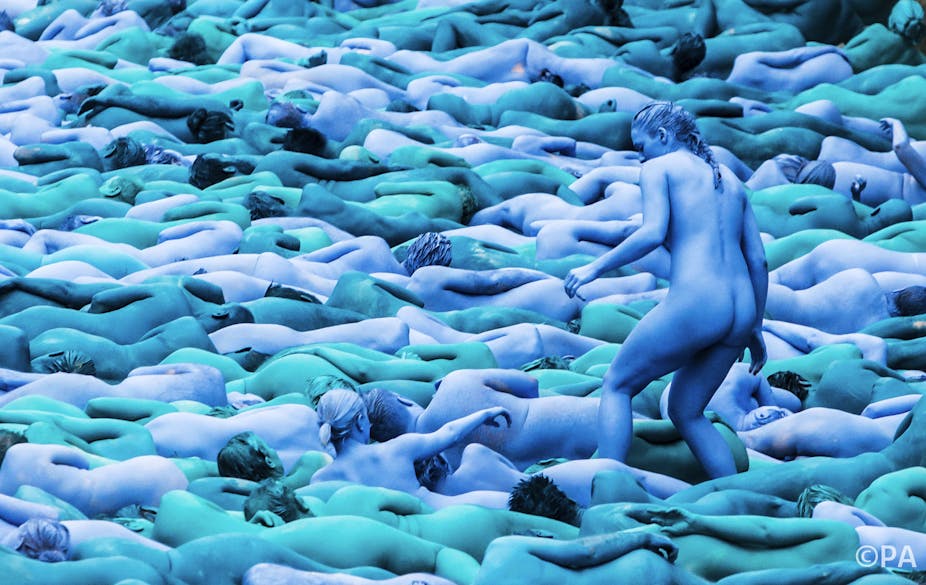I doubt I shall ever see blue in the same way again, since blue paint on my skin was the only thing covering my nakedness. I was among the 3,200 people – strangers to one another when it all began – who took part in the largest naked photo shoot in Britain, wearing nothing but four shades of blue body paint.
This work of performance art, named The Sea of Hull, was conceived by New York-based photographer Spencer Tunick and commissioned by the Ferens Art Gallery in Hull in north-east England as part of the city’s place as UK Capital of Culture in 2017, with Tunick’s exhibition as one of its highlights.
Tunick’s work has been widely discussed in academic literature as much as in the tabloids. But in the book Judging the Image by sociologist Alison Young, she describes Tunick’s early years and struggles against the law in the US, and also includes comments from those who have participated in his many installations. The spectrum of feelings aroused in those participating in Tunick’s work – as described in the book – echo the sentiments I have just heard expressed from my fellow participants in Hull.
My nude buddy summarised the event as joy, community, and release. And these are the three words with which I want to develop an approach to Tunick’s work and try to explain the reasons that led me to be a part of his human sea.
Joy, community and release: human essentials
I first came across Tunick’s work in 2002, when I saw his exhibition at the Museum of Contemporary Art in Montreal, Canada. It has taken 14 years for me to be able to make it to one of his installations, but my desire to do so never faded – something for which Young provides an explanation in her book:
Tunick’s great achievement as an artist is that his work is premised upon offering individuals the uncanny experience of being simultaneously the object of the image and the performance.
The dynamics of the acceptance or rejection of human bodies, either naked or clothed, rely on many factors and are culturally determined. The human body, as the physical essence of humanity, is at the core of the controversy. (I am not even going to approach the issue of sex. Not least because there is no sexual element in Tunick’s installations at all, but also because the complexities of human sexuality have already been masterly summarised by Patrick Clarkin in his fascinating series Humans are (Blank)-ogamous.)

Being part of Tunick’s installations provides an overwhelming sense of joy. It is exhilarating to realise that we can break socially prescribed barriers. Ultimately, the struggle is with ourselves: will we be brave enough to bare it all? Once nude, the feeling of joy is indescribable. From a purely physiological point of view, our “hormones of happiness” – endorphins, dopamine, and serotonin – will be unleashed, with knock-on effects on the body, including boosting the immune system.
Humans are social mammals, and cooperation and altruism are core evolutionary traits. In his book Race, monogamy, and other lies they told you, anthropologist Agustin Fuentes explained that cooperation is what humans do best, and what makes us such a successful species.
Tunick’s installations provide a feeling of community that is not easy to find in our daily lives, but one to which we are evolutionarily hardwired to seek. The sense of release emerges when the feelings of joy and community lead us to realise that we have become better human beings – more inclusive, and with a greater capacity for acceptance.
What next?
If you assumed Tunick would take a break for a little while after navigating the Sea of Hull, you’d be wrong: he is already channelling all his creative energy into, of all places, the Republican National Conference, in Cleveland, Ohio. Tunick is now looking for 100 women who will pose naked while holding mirrors to reflect:
… the knowledge and wisdom of progressive women and the concept of “mother nature” … The mirrors communicate that we are a reflection of ourselves, each other, and of the world that surrounds us. The woman becomes the future and the future becomes the woman.
I am seriously considering dropping everything I have currently going on and hopping on a plane, right now, to be one of those rays of sunshine in Cleveland. This will be an installation focused on equal rights, specifically on women’s rights – values I treasure and fight for everyday. Do I need any other reason? I don’t think so.

